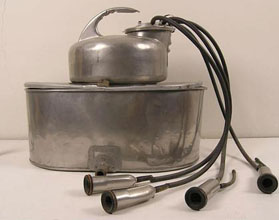Milking
Milk out the udder regularly from the day of calving. Milk can be used for usual human consumption from the 3rd or 4th day onwards. Animals producing more than 12 kg of milk per day can be milked 3 times a day. Keep the intervals between milking almost equal (> 6-8 hours).
Take care to have clean practices during milking. Wash the udder properly and mop it with a clean towel. In organised farms machine milking can be used.Use only properly cleaned utensils for milking and storage of milk. Keep the surroundings clean and free from dust. Take care that dung and urine do not splash into the milking pail. Milking process should be completed as fast as possible because the effect of letting down remains for about 5-6 minutes only. The udder should be completely milked out at each milking.
Source of contamination of milk and control measures
|
Source of contamination |
Control measures |
|
Exterior of udder |
Wash and wipe udder. |
|
Interior of udder |
Check for mastitis using strip cup |
|
Air and dust in cattle shed |
Avoid dusty environment at milking time |
|
Flies and other insects |
Eliminate breeding places |
|
Milker |
Practice clean habits, |
|
Utensils |
Clean, sanitise and dry before use. |
Milking machine

Milking of cows can be done by machines. These work on the principle of negative pressure. A vacuum pump sucks air out of the system. The teat cups are attached to the teats after letting down. Due to sucking action of the machine negative pressure is produced around the teat and milk flows out. From the teat cups the milk is drawn into milk tanks or milk cans through tubes.
The main advantage with the milking machine is that labour can be saved. Also, as the milking can be done quicker, the high yielders can be milked completely. Contamination of milk also can be reduced as the milk does not come in contact with outside objects.
Care of Milk
Immediately after milking the milk should be transferred from the shed because milk is capable of absorbing odours from the atmosphere. Straining through cloth, wire gauze, plastic sieve is done to remove large particles of foreign materials like straw, hair, insects, grass, dust etc. After each use the strainer should be washed and sanitized.
Cooling of Milk
The scientific reason for the cooling of milk is to inhibit multiplication of bacteria. A temperature of about 5oC will maintain the milk in this state. Cooling is done by various methods in large dairy. Under farm conditions the milk cans are kept in a tank containing cold water, the level of water in the tank being above the level of milk in the can. Milk should be transported to the collecting or selling point within four hours under the climatic conditions prevailing in Kerala. Delay in this, without proper cooling will result in development of acidity and curdling of milk. Transportation is done in cans. Can should be full to avoid agitation and churning.
Various metals and their alloys are used for the manufacture of dairy utensils. Metals like iron, copper etc. are not suitable because they are soluble (in traces) and produce undesirable chemical changes resulting in odd flavour and bad taste. Heavily tinned copper, galvanised iron and 18:8 chrome nickel steel are quite satisfactory but they are very costly. Aluminium and aluminium alloys are the best under our conditions. They are comparatively cheap, quite durable and free from action by milk constituents. They can be easily cleaned and sanitised. The most important aspect in the production of high quality milk is the cleaning and sanitation of dairy utensils. The dairy utensils should be cleaned immediately after use and dried. This will avoid the accumulation of milk residues, which result in bad odour, accumulation of milk stones, crypts, rust etc. on the can. The following procedure should be followed.
The utensils should be rinsed with clean cold water 2-3 times till the rinsed water is almost colourless. Alkaline detergents are used if hand washing is practised. The concentration should be adjusted so that it will not affect the hand. Detergent powders available are mixtures containing sodium carbonate and other cleaning agents like sodium hexametaphosphate, trisodium phosphate, sodium metasilicate etc. These ingredients should be selected depending upon the metal of the utensil.
Sanitation is done to kill all disease producing micro organism. The process of sanitation can be done by boiling water, steam or chemicals. Steam jet may be directed into the can for 2-3 minutes. Boiling water should be poured into the can and kept closed for 30 minutes. The temperature of the can should be above 85oC. Chemicals such as Hypochlorites (Sodium and Calcium hypochlorites) are used for chemical sanitation. Their strength is based on available chlorine. A strength of 200 ppm (available chlorine) for 2 minutes will be quite satisfactory. Quaternary ammonium compounds (50 ppm) and iodophores (50 ppm) can also be used. The residues of these chemicals if present, may affect the growth of desirable microflora used in fermented milk products.
